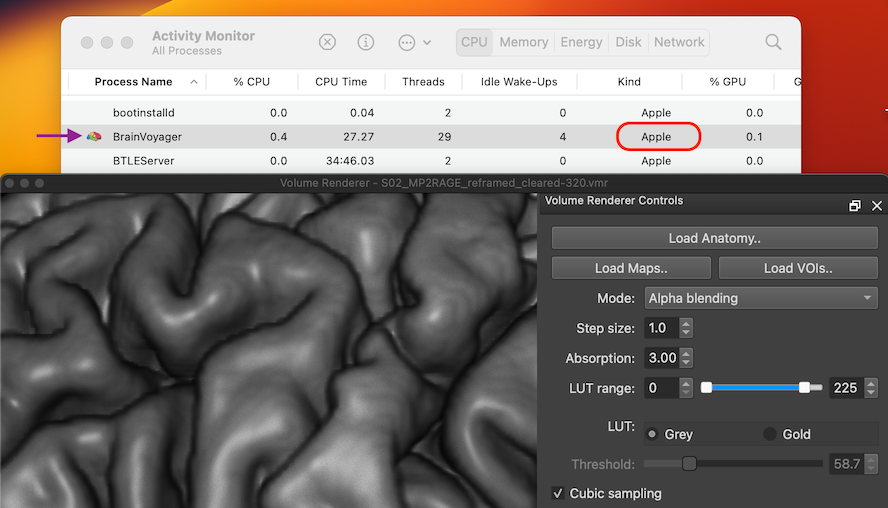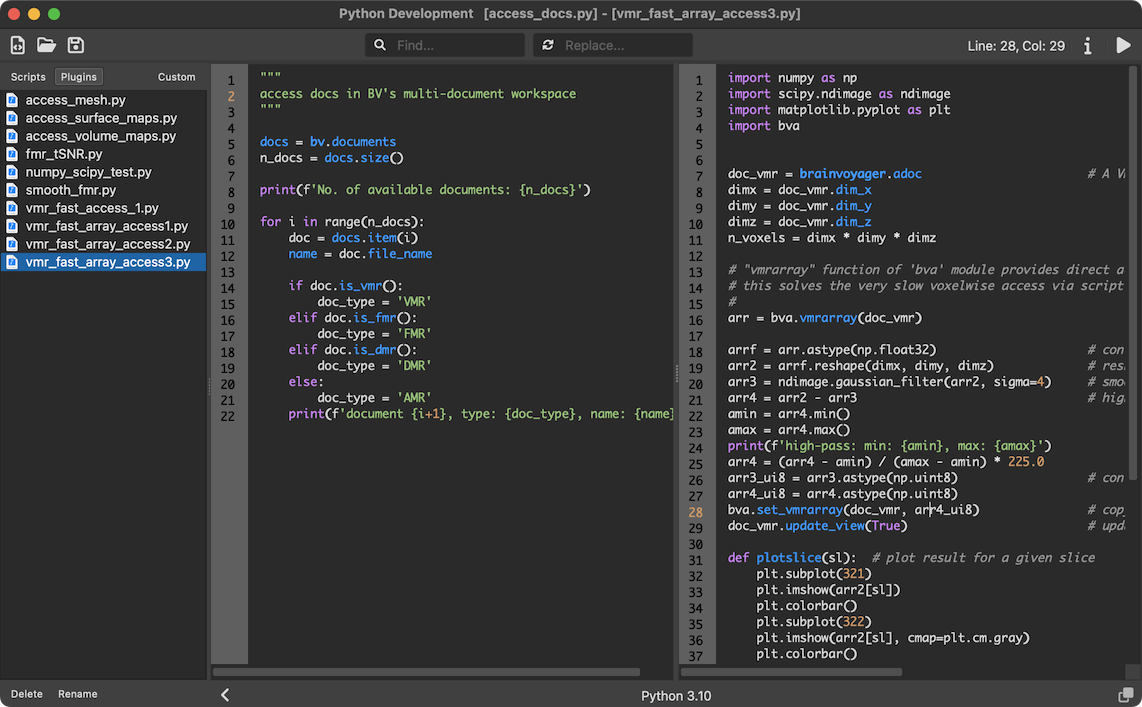Volume Rendering
BrainVoyager 23 Now Available with Native Apple Silicon Support
17 10, 23
We are happy to announce the availability of BrainVoyager 23.0 and BrainVoyager 23.0 EDU! This is a major release introducing important new features. A major focus of this release was maximising the high-performance, energy-efficient capabilities of Apple Silicon Macs for BrainVoyager. Every aspect of BrainVoyager has been considered with respect to the question how to benefit best from a native Apple Silicon implementation. The result is amazing graphics and compute performance based on a native arm64 compiled binary and usage of Apple's Metal and Accelerate frameworks. The snapshot below shows an entry of BrainVoyager 23 in Activity Monitor: the "Apple" entry in the "Kind" column identifies BrainVoyager as a native Apple Silicon application.

Another highlight of this release for all platforms is the new real-time volume renderer that is partially visible in the screenshot above. While BrainVoyager always had volume rendering capabilities, this is the second time where a new implementation was needed to provide more possibilities and more advanced rendering results. Another major focus of this release was enhanced Python integration: The approach to embed the Python interpreter has been fundamentally changed (based on 'PySide6') to provide more integrated, powerful and future-proof Python support. The latter will allow in a future release to also use BrainVoyager functionality from outside the application enabling the use of any Python development environment. But also the internally offered Python IDE has been substantially improved in this release including, for example, side-by-side editors, search and replace, multi-line indentation and shell commands. A snapshot of the new Python editor is shown below.

BrainVoyager 23 also introduces Lanczos interpolation, which is an optimised windowed sinc interpolation variant that produces at least as good results as standard windowed sinc interpolation but with reduced computation time on CPU and GPU (using Metal on macOS). Furthermore, GIFTI mesh files are now supported as a native format that can be loaded like BrainVoyager .SRF files directly from the Meshes menu; GIFTI functional map ('.func.gii') and label files ('.label.gii') are also supported. These as well as many other new features, enhancements and bug fixes are described in the release notes and the updated 23.0 User's Guide that can be viewed within BrainVoyager, but also here online as well as via a beautiful eBook. To install BrainVoyager 23 for your operating system, go directly to the Downloads page of your platform:
Another highlight of this release for all platforms is the new real-time volume renderer that is partially visible in the screenshot above. While BrainVoyager always had volume rendering capabilities, this is the second time where a new implementation was needed to provide more possibilities and more advanced rendering results. Another major focus of this release was enhanced Python integration: The approach to embed the Python interpreter has been fundamentally changed (based on 'PySide6') to provide more integrated, powerful and future-proof Python support. The latter will allow in a future release to also use BrainVoyager functionality from outside the application enabling the use of any Python development environment. But also the internally offered Python IDE has been substantially improved in this release including, for example, side-by-side editors, search and replace, multi-line indentation and shell commands. A snapshot of the new Python editor is shown below.

BrainVoyager 23 also introduces Lanczos interpolation, which is an optimised windowed sinc interpolation variant that produces at least as good results as standard windowed sinc interpolation but with reduced computation time on CPU and GPU (using Metal on macOS). Furthermore, GIFTI mesh files are now supported as a native format that can be loaded like BrainVoyager .SRF files directly from the Meshes menu; GIFTI functional map ('.func.gii') and label files ('.label.gii') are also supported. These as well as many other new features, enhancements and bug fixes are described in the release notes and the updated 23.0 User's Guide that can be viewed within BrainVoyager, but also here online as well as via a beautiful eBook. To install BrainVoyager 23 for your operating system, go directly to the Downloads page of your platform:
- BrainVoyager 23.0 for Apple Silicon and Intel Macs
- BrainVoyager 23.0 for Windows 10 and 11
- BrainVoyager 23.0 for Linux

